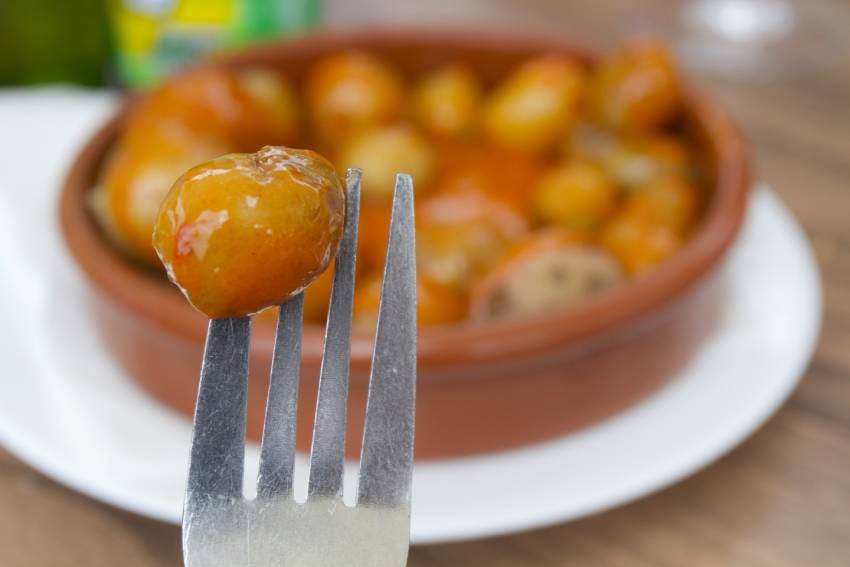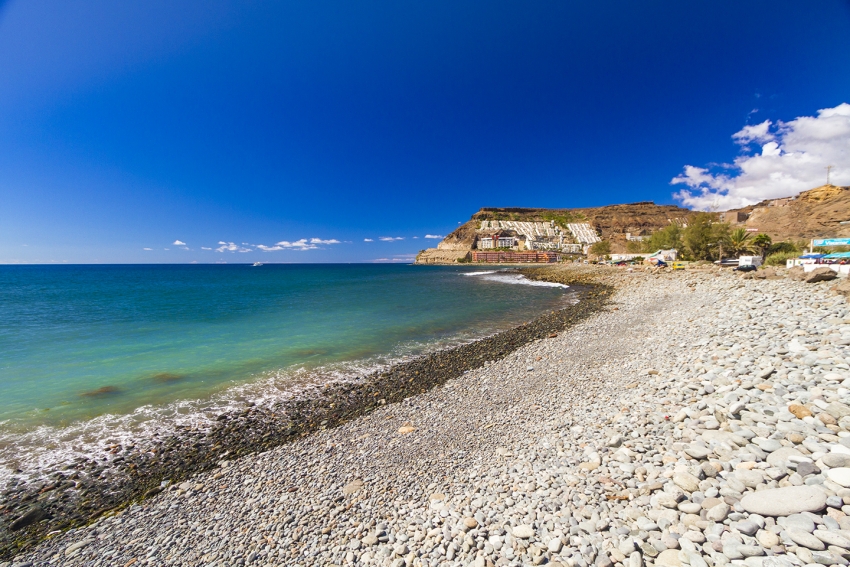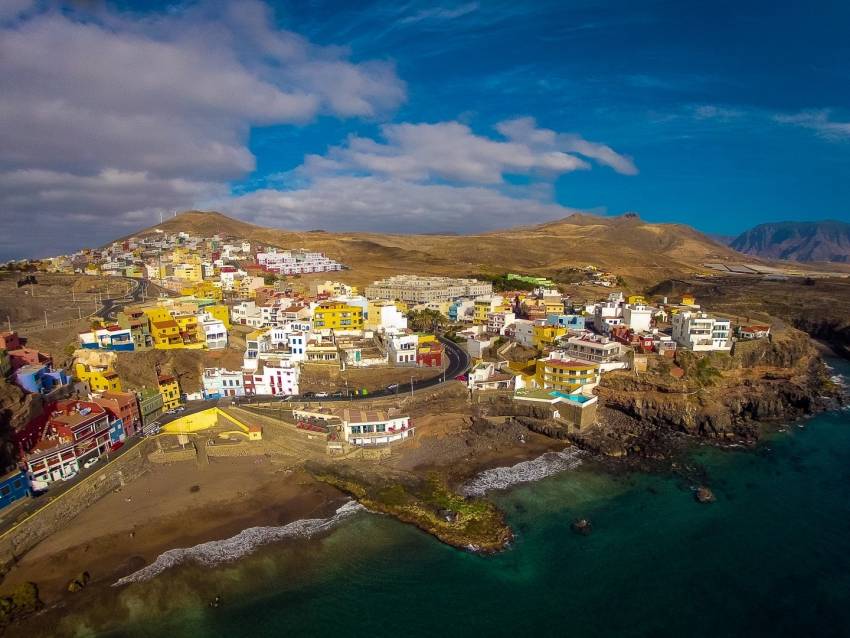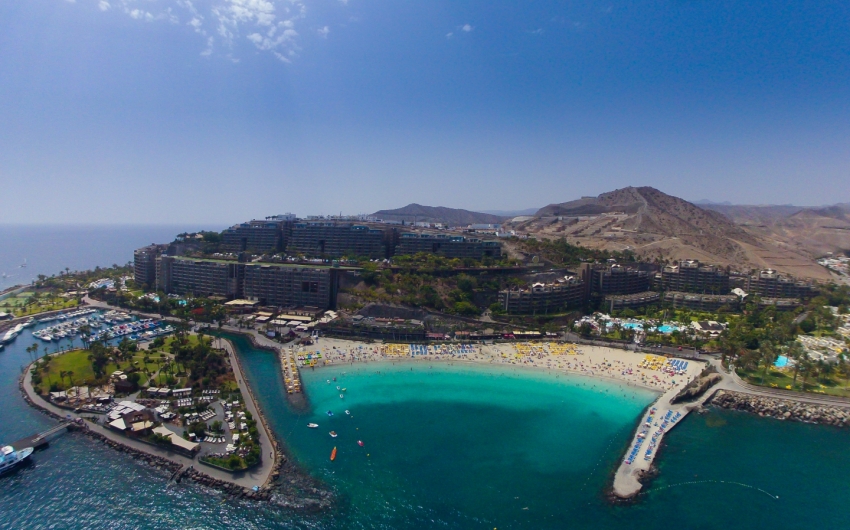Where In The World Can You Eat Old Clothes and Wrinkly Popes?
That would be the Canary Islands, where some traditional food dates back to prehistoric times but all of it is bursting with island flavour.
Going Green: Canary Islands Green Mojo Sauce Recipe
Mojo is the quintessential Canaria sauce. The red form, served with little wrinkled potatoes is the most famous kind, but the herby green variety is just as good. It's intense colour and flavour come from fresh coriander (cilantro).
Green mojo is traditionally served drizzled over big pieces of boiled potatoes, on fried fish or on slices of octopus. On Gran Canaria you rarely get it with wrinkly potatoes (papas arrugadas) but it is served this way on other islands.
Mojo verde is very similar to Portuguese salsa verde but uses coriander instead of parsley. It may be yet another reminder that many of the earliest settlers in the Canary Islands came from the Portuguese island of Madeira, just to the north of the Canaries.
To make enough mojo for a decent dipping session you need:
A good bunch of fresh coriander
Six fat cloves of garlic
Half a teaspoon on cumin seeds
A big pinch of salt
One fresh green chilli pepper
Olive oil
Cider or wine vinegar (not malt vinegar: too strong)
A hand full of breadcrumbs to thicken
Grind up the coriander leaves and the tops of the stalks with the garlic, salt, chilli and cumin. You can use a blender but a pestle and mortar does a better job. You want to end up with a smooth paste with no oil floating on top.
Add about 200 ml of olive oil and 50 ml of vinegar and mix well until you get a thick, sticky sauce. If the mixture is too thin add some breadcrumbs. If it is too thick dilute it with a bit of white wine.
Serve mojo verde straight away as a dipping sauce with crusty bread, or with almost any other Canarian dish. It goes particularly well with fried fish. You can store it in the fridge for a couple of days but it loses its flavour quickly.
Some people add a handful of green peppers (capsicum) and a teaspoon of dried oregano leaves. Other substitute half the coriander for parsley. These extras are not traditional but do create a green mojo sauce with more depth of flavour.
The Legendary Red Mojo Sauce: Gran Canaria Recipe
Mojo sauce is the Canary Islands' most famous condiment and one half of "papas arrugadas con mojo", our most popular dish. It is tasty, garlicky and spicy, but not actually that fiery unless you get Mojo Picon; the chilied up version.
Mojo sauce is either red or green (mojo rojo and mojo verde) depending on whether it is flavoured with paprika or fresh coriander. Both types also contain oil, vinegar, cumin, garlic and chili. The red form is served with small, salted potatoes while the green form is traditionally served with fish.
The name mojo probably comes from the Portuguese word molho, which means sauce: A reminder that many early Canarian settlers came from the nearby Portuguese island of Madeira. They migrated to the Canary Islands to start off its sugar cane industry.
Red Mojo Recipe
Makes enough for a good portion of mojo sauce for papas arrugadas for four people.
Ingredients
5 garlic of cloves
A teaspoon of cumin seeds
2 or 3 dried birds eye chilies, more for Mojo Picon
A good pinch of salt
A teaspoon of smoky paprika or pimentón
3 tablespoons red wine vinegar
5 tablespoons olive oil
3 or 4 tablespoons breadcrumbs to thicken
A splash of water to loosen the sauce, or a couple of roasted tomatoes.
Method
Dry fry the cumin until it starts to pop to release its flavours. Grind it up in a pestle and mortar along with the dried chilies, salt, pimentón and the garlic cloves until you get an even paste. Add the olive oil and vinegar and mix well. Add breadcrumbs to thicken and water to loosen. Mojo should be thick enough to stick to the potatoes but not be lumpy.
Mojo Rojo is almost always served with papas arrugadas: Small potatoes cooked in sea water or very salty water. The salt sucks water out of the potatoes, leaving them with wrinkled skin.
To make papas arrugadas boil small potatoes in just enough sea water or salty water to cover them. Leave the pan uncovered and cook until the water is almost all gone. Leave them in the open pan until they are dry and the skin is covered with a fine white crust of salt.
To make proper papas con mojo pour the sauce generously over the potatoes rather than in a separate dish. Squash each potato before removing it from the sauce for maximum absorption. Papas con mojo goes brilliantly with good Canarian goat's cheese.
Top Ten Things to do at Christmas in Gran Canaria
Christmas in Gran Canaria tends to be a laid-back sunny affair and most people just kick back and relax. However, there's plenty of festive events in local areas and in the resorts. Here's ten great options for fun Christmas activities in Gran Canaria. Sunny Christmas!
Sunbathe in a Santa hat
There's nothing like knowing that your in the sunshine in Gran Canaria while your friends are all at home in the cold. Pop on a Santa hat and sit back in the sunshine feeling warm and smug.
Annoy everybody at home
You can't spend Christmas in Gran Canaria without snapping a selfie by the beach and making sure everybody sees it. There's big Christmas trees by most of the beaches.
Visit the world's biggest sand nativity scene
Every year sand sculptors spend weeks creating a huge nativity scene on Las Canteras beach in the capital Las Palmas. It's so big it has boardwalks running through it. Entrance is free but the sculptors appreciate any tips. The Las Palmas sand nativity scene is down at the north end of the beach right by the giant Christmas tree.
Visit the pine forest for living Christmas trees
Sometimes it's hard to get into the Chtistmas state of mind when the sun is shining and it's boiling hot. The solution in Gran Canaria is to drive up to the highlands and walk through the pine forests. You should get a few cool blasts of air and even some mist to wake up the Christmas spirit.
Look for the cagón in the island's nativity scenes
Every town and shopping centre in Gran Canaria puts up a Belén or nativity scene for December and the beginning of January. They all show scenes from Jesus' life and range from basic scenes with hand made figures to huge, ornate displays with electric lights and waterfalls.
Look carefully and each one has a figure doing something that isn't mentioned in the bible. The cagón is a man doing a pooh and is hidden behind a palm tree or a house somewhere in the scene.
Christmas markets
Every town in Gran Canaria puts on a Christmas market in late December and there's food stalls and concerts in most town squares. Events start in the fortnight before Chistmas day and last until January 6. The Canarians really know how to party.
Camel ride in the dunes
In Gran Canaria it's traditionally the Three Kings on their camels that brings the presents on January 6, although Santa is more popular with the kids as they get to play with their presents for longer before school. Why not take a camel ride through the Maspalomas dunes for a Kingly expoerience. It's the perfect spot for that sunshine selfie.
Christmas dinner
You won't get turket and all the trimmings in local areas but there's plenty of choice in the resorts for all nationalities. In local areas look out for truchas: Little pastries filled with sweet potato or sweet marrow.
Skip the whole affair
Bored of the consumerism of Christmas? Book a rural house in Gran Canaria or just go to a resort and ignore the Christmas offers. You can sit on the beach and relax for a week while everybody at home is busy getting stressed with last minute present shopping.
Give something back
The local Casa Galicia charity runs an annual collection of toys and food for people on the island who struggle at Christmas. They ask for new toys and food with a long shelf life. There are drop off points in all towns and resorts, including Cardenas Real Estate offices in Arguineguin, Mogán and Puerto Rico.
Getting from Gran Canaria Airport to Playa del Inglés
Playa del Inglés is about half an hour down the motorway from Gran Canaria airport and you can't really get lost. You can rent a car or get a bus or taxi to the resort.
Gran Canaria Beaches: All Change at Tauro
Tauro beach is Gran Canaria's lazy Sunday chill-out beach for people old enough to remember the resorts going up. They gather at weekends to listen to proper music and drink the island dry. With a long pebble beach, several ramshackle bars and a motely colection of decaying houses, Tauro is the anti-Amadores. For now!
Gran Canaria Seasons And The Best Times To Visit
The best time to visit Gran Canaria, without a doubt, is now. However, here's what to expect at any time during the year.
When is the best time to visit Las Palmas
There’s no bad month to visit Las Palmas city as its climate is one of the world’s best, but the weather does have its quirks. Here’s a season-by-season guide to the weather in Gran Canaria’s capital.
Top Spots for Mouthwatering Local Seafood in North Gran Canaria
Gran Canaria's North Shore, sandwiched between the breakers and the banana plantations is riddled with authentic seafood restaurants. Ignore the roadside warehouse restaurants between Bañaderos and San Felipe and head for these tried-and-tested spots instead.
Puerto de las Nieves
Puerto de las Nieves in the far north west of Gran Canaria caters to mobs of seafood-hungry Las Palmas locals at weekends. You won’t get a table at the beachfront restaurants after 13.30.
Visit during the week and Puerto de las Nieves reverts back to its natural, peaceful state. The odd carload of intrepid tourists that have driven from Las Palmas or along the West Coast road are often the only people on the terraces.
Puerto de las Nieves shuts up shop during the evenings. Most restaurants close but you’ll always find somewhere to knock out a plate of calamares.
Top Picks
El Dedo de Dios restaurant is the only one to the left of the old jetty. While it doesn’t have outdoor seating you can sit by the big windows if you arrive early. The food excellent and the best value in town. The Dedo opens at night.
The quintessential Puerto de las Nieves seafood restaurant with a whitewashed terrace right by the beach and fishing nets on the walls. The seafood is good and the slight premium you pay is worthwhile if you can get an outside table.
Sardina del Norte
This tiny fishing harbour clings improbably to the narrow platform at the base of a high sea cliff in north west Gran Canaria. It’s a popular local spot because of its sandy beach, value restaurants and top-notch dive spots
The beach is small and sometimes gets washed away in winter but is the only sandy beach along the north coast. It has toilets, showers and sunbathing platforms.
Sardina’s restaurants serve seafood and Canarian dishes and their prices are local.
Top Picks
Right by the diving jetty the ramshackle El Ancla restaurant does great seafood, serving it without a trace of irony to divers just out of the ocean. The seafood and vegetable fry up is superb.
Embedded in the cliff overlooking the beach Mama Lolilla has to be one of Gran Canaria’s Top Location Restaurants. Arrive early (before 13.30) and you get the one-table terrace with the best view.
La Puntilla
Las Canteras beach ends at La Puntilla but the walkway continues all the way to El Confital beach two kilometres north. It’s a much quieter part of the city with residential streets and little rocky bays.
The restaurants here are local and serve seafood at lower prices than along the beachfront.
Amigo Camillo is first restaurant on the front as you walk north from the big square at the north end of the beach. It's right on the edge of the rocks with greats views from its covered terrace. The calamares and puntitas (deep-fried baby squid) are delicious and there’s always fresh fish on display.
Las Coloradas
The most northerly village in Las Palmas is tucked away in the La Isleta Peninsula and surrounded by a military base.
Las Coloradas isn’t by the sea and its restaurants don’t have a great view. However, its been a city hotspot for seafood for decades and after a lull is coming back onto the radar.
The Mirador del Atlante
Drive west out of Las Palmas along the coast road and you soon get to Tony Gallardo's amorphous but feminine sculpture. It represents the legend of Atlantis and looks like a giant woman facing the ocean.
Just past the sculpture is the Mirador del Atlante outdoor restaurant serving seafood and local dishes. It’s the only decent restaurant along the north coast with a good view of the city although you do pay for the location.
To reach the Mirador as you come into Las Palmas you have to drive past and turn around in the city: Just take the first exit past the bridge and use the roundabout by the Las Arenas shopping centre.
El Roque
Every house in colourful El Roque village sits on a huge rock sticking out into the ocean in north Gran Canaria. Perched right at the tip is the Italian run Locando El Roque. It does a range of pasta and fresh fish and while it's more upmarket than most seafood places in north Gran Canaria, its location is exceptional.
Puertillo
The only sandy beach along the Gran Canaria North Shore, El Puertillo has a couple of fantastic local seafood spots right by the sand. There's not much to choose between them and they fill up fast at weekends.
Gran Canaria's Insanely Garlicky Breakfast Sausage
There’s a faint odour of garlic in most of Gran Canaria’s little shops and it comes from the string of vivid orange sausages next to the cheese.
Chorizo de Teror is the Canarian version of Spanish sobreasada but is rammed with garlic. It’s basically a thick pate in a sausage skin and is served spread on crusty bread. Canarians eat it at any time but it’s popular as a breakfast snack during fiestas.
Be warned: Chorizo de Teror is a breath monster of a snack and we don’t advise eating it the day before you fly home.
The Terror in Teror
For the island’s most authentic and potent chorizo head to Teror town on a Sunday and buy one in the market along with a fresh bread roll. Just squeeze out the contents into the halved roll and spread with the skin. Then tuck in.
We guarantee that the locals will stop and watch you. They love their Chorizo de Teror but very few tourists are brave enough to try it.
Alex says: Dial down the garlic by cooking chorizo de Teror: Put it in a bowl with about an inch of a strong spirit such as vodka or aguardiente (local firewater made from the remnants of grape pressings). Light the alcohol and the heat shrinks back the sausage skin and melts away some of the fat. Wait until all the booze has burned off and help yourself. You’ll still stink of garlic the next day but the flavour mellows with the heat.
Chorizo de Teror is an authentic Canarian treat but you never get it in hotels or in tourist restaurants: The taste is just too strong for most visitors. If you are inspired to give it a go please let us know what you think of it.
Gran Canaria Info recommends:
- Default
- Title
- Date
- Random






















